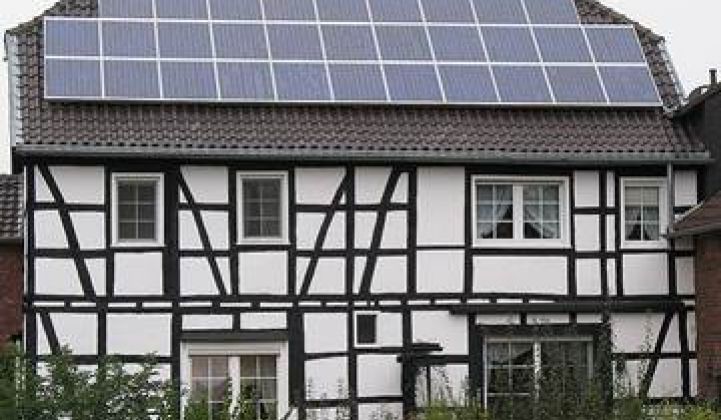Editor's note: Our reporter, Herman Trabish, tunes into the viewpoint of a few solar installers on the virtues of particular panel vendors.
***
SolarCity doesn’t sell or install SunPower panels, a rival installer told GTM, “and SunPower, it is agreed on, is the best panel. They have the highest cell efficiency and the highest panel efficiency.” SunPower’s panels have “a 20.1 percent efficiency,” the installer, who will remain unnamed, explained, while the other panels on the market “are around 14 percent to 15 percent.”
“SunPower started as a panel maker. SolarCity started as an installer,” he went on. And while SolarCity pioneered the no-upfront-cost lease program for residential rooftop solar installations, “SunPower now has a similar program so consumers don’t have to choose between panel quality and high upfront costs.” But, he added, “they still have different business models because SunPower sells its own panels.”
“There is a really intense competition between them,” the independent installer said. They are “the two biggest players in the market.” He chooses to offer his customers SunPower panels even though they are more costly, the installer added, precisely because of their higher quality. “It’s a big question for everybody now,” he explained. “How much more is the better panel worth?”
_540_449_80.jpg)
Ben Tarbell, SolarCity Vice President for Products, answered for his company by describing SolarCity as "technology-agnostic." He added, “We don’t have commitments to any one manufacturer. Today we’re installing panels from companies like Kyocera, Yingli, Trina, and Suniva. We’ve installed more than 20 different types of panels."
“We’re very concerned about panel reliability and quality,” added SolarCity spokesperson Jonathan Bass. “We constantly re-evaluate technology and choose the best technology available.”
“We offer high-efficiency modules,” Tarbell said. “The situation that merits it is if you are trying to get high production out of a relatively smaller space.” But, he explained, “the measure of the economics of a panel is the cost per kilowatt-hour produced. If you’ve got a higher efficiency panel that is more expensive, typically, the cost per kilowatt-hour produced is also going to be higher.”
More importantly, he added, “Let’s make sure we don’t conflate efficiency with quality.” Efficiency is not what matters to most customers,” he explained. “It’s cost-effectiveness.” He then said, “If all things were equal, higher efficiency is likely to yield a better cost of electricity. But the challenge is that higher efficiency panels often cost a lot more. You lose any benefits, in terms of cost effectiveness, that efficiency would enable, because you’re paying much, much more for the benefits that you gain.”
Materials Science/Mechanical Engineering Professor at Queen’s University and Michigan Technological University Joshua Pearce, whose landmark 2011 study showed rooftop solar’s levelized cost of electricity (LCOE) has reached grid parity, essentially agreed with Tarbell. But “it is complicated,” Pearce added.
SunPower’s products, he said, “are overall more efficient modules and with better device design and light capture than standard modules. This gives them more energy per watt and more watts per square feet.”
For “a small apartment complex in Japan,” Pearce said, that needs “the highest efficiency modules or else you’re not going to get anything, you can’t mess around with a low-efficiency amorphous silicon panel.”
But, he said, “if you are in a typical American home and you’re putting on a four-kilowatt system, and you’ve got so much space that it doesn’t really matter, then you can go to the lowest cost per watt,” even though “you’re still looking for the lowest cost per kilowatt-hour and that lowest cost per watt may steer you in the wrong direction if you’re not paying attention to what the output is of different types of modules in different locations.”
The average consumer, Pearce said, “is going to buy polysilicon modules, because they are the least expensive.” Most of the silicon, he explained, comes “from only a couple of suppliers” and is made in China into “more or less the same quality of wafers that are then put in the same type of modules, no matter which company it is, and shipped to your door.”
Pearce said a consumer isn’t likely to go wrong with panels from any of the name brands. “You can have some faith that because they’re selling tens of thousands of them, they’re more or less good. I wouldn’t disparage any of the top manufacturers. I think all of them are pretty good.”
Bass said SolarCity’s success is based on designing “a system that is optimal for the customer,” whether or not it includes the most efficient panels.
“You have a solar system that produces 100 kilowatt-hours over a given period of time and it costs $100,” Bass hypothesized. “And you have another solar system that produces 120 kilowatt-hours over the same period of time but it costs $140. Which system are you going to buy?"
Elaborating on this example, he added: “And let’s say you can increase the area of the solar system that produced 100 kilowatt-hours to produce 120 kilowatt-hours and pay $120. There you have a slightly larger system in area that produces 120 kilowatt-hours for $120 and a slightly smaller system that produces 120 kilowatt-hours for $140. Which system are you going to buy?”



